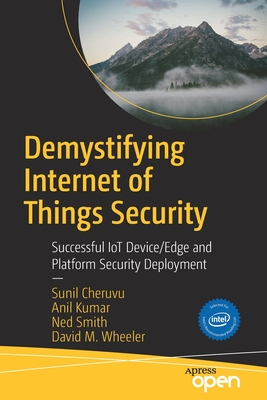Demystifying Internet of Things Security: Successful Iot Device/Edge and Platform Security Deployment
暫譯: 揭開物聯網安全的神秘面紗:成功的 IoT 裝置/邊緣及平台安全部署
Cheruvu, Sunil, Kumar, Anil, Smith, Ned
商品描述
Break down the misconceptions of the Internet of Things by examining the different security building blocks available in Intel Architecture (IA) based IoT platforms. This open access book reviews the threat pyramid, secure boot, chain of trust, and the SW stack leading up to defense-in-depth.
The IoT presents unique challenges in implementing security and Intel has both CPU and Isolated Security Engine capabilities to simplify it. This book explores the challenges to secure these devices to make them immune to different threats originating from within and outside the network. The requirements and robustness rules to protect the assets vary greatly and there is no single blanket solution approach to implement security.
Demystifying Internet of Things Security provides clarity to industry professionals and provides and overview of different security solutions
What You'll Learn
- Secure devices, immunizing them against different threats originating from inside and outside the network
- Gather an overview of the different security building blocks available in Intel Architecture (IA) based IoT platforms
- Understand the threat pyramid, secure boot, chain of trust, and the software stack leading up to defense-in-depth
Who This Book Is For
Strategists, developers, architects, and managers in the embedded and Internet of Things (IoT) space trying to understand and implement the security in the IoT devices/platforms.
商品描述(中文翻譯)
透過檢視基於 Intel 架構 (IA) 的物聯網平台中可用的不同安全構建模塊,來拆解對物聯網的誤解。本開放存取書籍回顧了威脅金字塔、安全啟動、信任鏈以及通往深度防禦的軟體堆疊。
物聯網在實施安全性方面面臨獨特挑戰,而 Intel 擁有 CPU 和隔離安全引擎的能力來簡化這一過程。本書探討了保護這些設備的挑戰,以使其免受來自內部和外部網路的不同威脅。保護資產的需求和穩健性規則差異很大,並且沒有單一的通用解決方案來實施安全性。
揭開物聯網安全的神秘面紗 為業界專業人士提供了清晰的解釋,並概述了不同的安全解決方案。
您將學到的內容
- 安全設備,使其免受來自內部和外部網路的不同威脅
- 概述基於 Intel 架構 (IA) 的物聯網平台中可用的不同安全構建模塊
- 理解威脅金字塔、安全啟動、信任鏈以及通往深度防禦的軟體堆疊
本書適合誰閱讀
嵌入式和物聯網 (IoT) 領域的策略家、開發人員、架構師和管理者,試圖理解和實施物聯網設備/平台的安全性。
作者簡介
Sunil Cheruvu is a Principal Engineer in the Platform Engineering Division of IOTG at Intel Corporation and has been involved in architecting complex systems involving HW/FW/SW for almost 23 years. Implementing the code for Baseline Privacy security in DOCSIS compliant Cable Modems when he was a Senior SW Engineer at 3com and a SW Staff Engineer at Conexant. Working at Microsoft as a SW Design Engineer, he was the tech lead for Vehicle Networking involving the Bus and Protocol driver stacks. He took the stacks through the threat modeling and implemented the resolutions in what was released as the Windows Mobile for Automotive (WMfA) platform.
At Intel, he was the Content Protection lead and owned the system level architecture of Conditional Access and Trusted Data Path (end-2-end premium content protection within a SoC.) Architecting the security for embedded devices and in his current role as the Principal Engineer, owns the scaling of security (from below Atom to Xeon) and on multiple Operating Systems. He is the subject matter expert for IOTG security across Intel and outside of Intel.
Anil Kumar is a Principal Engineer in the Platform Engineering Division of IOTG at Intel Corporation, and is responsible for the Connectivity Platform Architecture across IOTG. In this role, he leads the effort with the planning team to create IOTG's first ever roadmap for connectivity solutions. He is currently driving platform and chip level integration of several key connectivity and communication technologies which are critical for Cyber Physical Systems. Anil joined Intel in 2007 as a design engineer in Digital Home Group. He served as Platform Architect for several Intel Architecture based Media Processors for TV and Set Top Box applications. As the chief architect in Intel Media Group Anil lead several designs that resulted in award winning consumer electronic device designs at CES. The world's first Google TV devices were based on reference design efforts lead by Anil as well. Prior to joining Intel, Anil held design engineering positions at multinational companies such as Fujitsu & Alcatel. He was instrumental in taking several designs from concept to production throughout his career.
Ned Smith is a Principal Engineer in the Open Technology Center (OTC) team in the Software Solutions Group at Intel Corporation. He is responsible for defining Internet of Things security architecture and standards for open IoT technologies. This includes defining IoT architecture for Open Connectivity Foundation (OCF) and IPSO Alliance. Ned chairs the Security, Privacy and Identity (SPI) work group in IPSO Alliance. He is co-author of the Internet Engineering Task Force (IETF) draft specification, draft-hardjono-ace-fluffy-03 that defines key management for constrained environments.
Ned joined Intel Labs in 1995 where he helped define the Common Data Security Architecture (CDSA) that was standardized by the Open Group. He chaired the Infrastructure Workgroup (IWG) in the Trusted Computing Group (TCG) from its inception until 2006. The IWG may best be known for its work on Network Access Control (NAC) standards that later became the Trusted Network Connect (TNC) working group within the TCG. The TNC standards were adopted by a majority of network security vendors supplying NAC products.
Ned has been highly influential within Intel having contributed to a long list of enterprise and office security technologies including Intel(R) Identity Protection Technology, Intel(R) Anti-theft Technology, Intel(R) Manageability Engine, Intel(R) Converged Security Engine, Intel(R) Trusted Execution Technology, Intel(R) Insider(TM), Intel(R) Virtualization Technology, Intel(R) Deep Defender(TM), Intel(R) Platform Trust Technology, Intel(R) Software Guard Extensions and numerous other security, privacy, identity and access management related projects.
Ned is a prolific inventor having received Intel's highest award for patent filing in 2014. He has more than 115 patents granted and over 290 patents pending.
Dave Wheeler is a Senior Principal Engineer in the Platform Security Division of IAGS at Intel Corporation and has thirty years' experience in software, security and networking. In his current role, Dave is responsible for research and development of new cryptographic algorithms and protocols, security APIs and libraries across Intel including for IoT platforms, performs security reviews on Intel's cryptographic implementations, and represents Intel at the IETF. Within the Internet of Things, Dave has contributed to Intel's Software-Defined Industrial Systems architecture and IOTG's Health Application Platform. Prior to Intel, Dave held various lead software and systems architecture positions at Motorola, Honeywell Bull, General Dynamics, as well as his own consulting firm. Dave has designed and built several hardware security engines, including a Type-2 security coprocessor for a software defined radio, and the Intel Wireless Trust Module, a hardware cryptographic coprocessor on the Intel XScale processor. He has implemented several cryptographic libraries and protocol layers, including an IPSec-type implementation for an SDR radio, header compression protocol layers for IP, TCP, and UDP over multicast, a connectionless network layer protocol, two-factor authentication verification over RADIUS for a firewall VPN, PPP for serial, an instant messaging protocol over Bluetooth, and many others. Dave has been a key contributor to other full-stack product implementations including Intel's Blue River Network appliance, several complete public Internet applications in PHP, JavaScript/Sails, and even VBScript. Dave has also worked on smartcard security for banking and gaming applications at a startup, Touch Technology. While at Motorola in 1992, Dave authored the "Security Association Management Protocol" for the National Security Agency, and subsequently spoke nationally about key management and key management protocols. He has led clean-room implementations for ISAKMP, IKEv2, and a custom network-keying protocol. Dave's extensive experience in security, networking, software and hardware is leveraged across a broad segment of Intel's Internet of Things to make Intel's products and software projects secure.
作者簡介(中文翻譯)
Sunil Cheruvu 是英特爾公司 IOTG 平台工程部的首席工程師,擁有近 23 年設計涉及硬體/韌體/軟體的複雜系統的經驗。在 3com 擔任高級軟體工程師及在 Conexant 擔任軟體資深工程師時,他負責為符合 DOCSIS 標準的有線調變解調器實作基線隱私安全的程式碼。在微軟擔任軟體設計工程師時,他是車輛網路的技術負責人,涉及總線和協定驅動堆疊。他帶領這些堆疊進行威脅建模,並實作解決方案,最終發布為 Windows Mobile for Automotive (WMfA) 平台。
在英特爾,他是內容保護的負責人,擁有條件存取和受信資料通道的系統級架構(在 SoC 內的端到端高級內容保護)。他負責嵌入式設備的安全架構,並在目前的首席工程師角色中,負責安全性的擴展(從 Atom 到 Xeon)以及多個作業系統的安全性。他是英特爾及外部 IOTG 安全的主題專家。
Anil Kumar 是英特爾公司 IOTG 平台工程部的首席工程師,負責 IOTG 的連接平台架構。在這個角色中,他與規劃團隊合作,創建 IOTG 首個連接解決方案的路線圖。他目前正在推動幾項關鍵連接和通信技術的平台和晶片級整合,這些技術對於網絡物理系統至關重要。Anil 於 2007 年加入英特爾,擔任數位家庭小組的設計工程師。他曾擔任多個基於英特爾架構的媒體處理器的平臺架構師,應用於電視和機上盒。作為英特爾媒體小組的首席架構師,Anil 領導了幾個設計,這些設計在 CES 獲得了獎項。世界上第一款 Google TV 設備也是基於 Anil 領導的參考設計。在加入英特爾之前,Anil 在富士通和阿爾卡特等跨國公司擔任設計工程師。他在職業生涯中對多個設計從概念到生產的過程中發揮了重要作用。
Ned Smith 是英特爾公司軟體解決方案小組的開放技術中心 (OTC) 團隊的首席工程師。他負責定義物聯網安全架構和開放物聯網技術的標準。這包括為開放連接基金會 (Open Connectivity Foundation, OCF) 和 IPSO 聯盟定義物聯網架構。Ned 主持 IPSO 聯盟的安全、隱私和身份 (SPI) 工作組。他是互聯網工程任務組 (IETF) 草案規範 draft-hardjono-ace-fluffy-03 的共同作者,該草案定義了受限環境的密鑰管理。
Ned 於 1995 年加入英特爾實驗室,幫助定義了由開放組織標準化的通用數據安全架構 (CDSA)。他從成立之初到 2006 年一直擔任受信計算小組 (TCG) 的基礎設施工作組 (IWG) 主席。IWG 以其對網絡存取控制 (NAC) 標準的工作而聞名,該標準後來成為 TCG 內的受信網絡連接 (TNC) 工作組。TNC 標準被大多數提供 NAC 產品的網絡安全供應商採納。
Ned 在英特爾內部影響深遠,對多項企業和辦公室安全技術做出了貢獻,包括 Intel(R) 身份保護技術、Intel(R) 反盜竊技術、Intel(R) 可管理性引擎、Intel(R) 融合安全引擎、Intel(R) 受信執行技術、Intel(R) Insider(TM)、Intel(R) 虛擬化技術、Intel(R) Deep Defender(TM)、Intel(R) 平台信任技術、Intel(R) 軟體保護擴展以及其他許多與安全、隱私、身份和存取管理相關的專案。
Ned 是一位多產的發明家,於 2014 年獲得英特爾的最高專利申請獎。他擁有超過 115 項已授權專利和超過 290 項待審專利。
Dave Wheeler 是英特爾公司 IAGS 平台安全部的高級首席工程師,擁有三十年的軟體、安全和網絡經驗。在目前的角色中,Dave 負責新加密演算法和協定的研究與開發,安全 API 和庫,涵蓋英特爾的各個領域,包括物聯網平台,對英特爾的加密實作進行安全審查,並代表英特爾參加 IETF。在物聯網領域,Dave 對英特爾的軟體定義工業系統架構和 IOTG 的健康應用平台做出了貢獻。在加入英特爾之前,Dave 在摩托羅拉、霍尼韋爾牛、通用動力以及他自己的顧問公司擔任各種領導軟體和系統架構職位。Dave 設計並建造了幾個硬體安全引擎,包括用於軟體定義無線電的 Type-2 安全協處理器,以及英特爾 XScale 處理器上的英特爾無線信任模組,這是一個硬體加密協處理器。他實作了幾個加密庫和協定層,包括 SDR 無線電的 IPSec 類實作、IP、TCP 和 UDP 的標頭壓縮協定層、無連接網絡層協定、通過 RADIUS 進行防火牆 VPN 的雙因素身份驗證驗證、串行的 PPP、藍牙的即時消息協定等。Dave 對其他全棧產品實作也做出了重要貢獻,包括英特爾的 Blue River Network 設備、幾個完整的公共互聯網應用程式(使用 PHP、JavaScript/Sails,甚至 VBScript)。Dave 還在一家初創公司 Touch Technology 從事銀行和遊戲應用的智能卡安全工作。1992 年在摩托羅拉時,Dave 為國家安全局撰寫了「安全協會管理協定」,並隨後在全國範圍內發表有關密鑰管理和密鑰管理協定的演講。他主導了 ISAKMP、IKEv2 和自定義網絡密鑰協定的清潔室實作。Dave 在安全、網絡、軟體和硬體方面的豐富經驗被廣泛應用於英特爾的物聯網領域,以確保英特爾的產品和軟體專案的安全。










